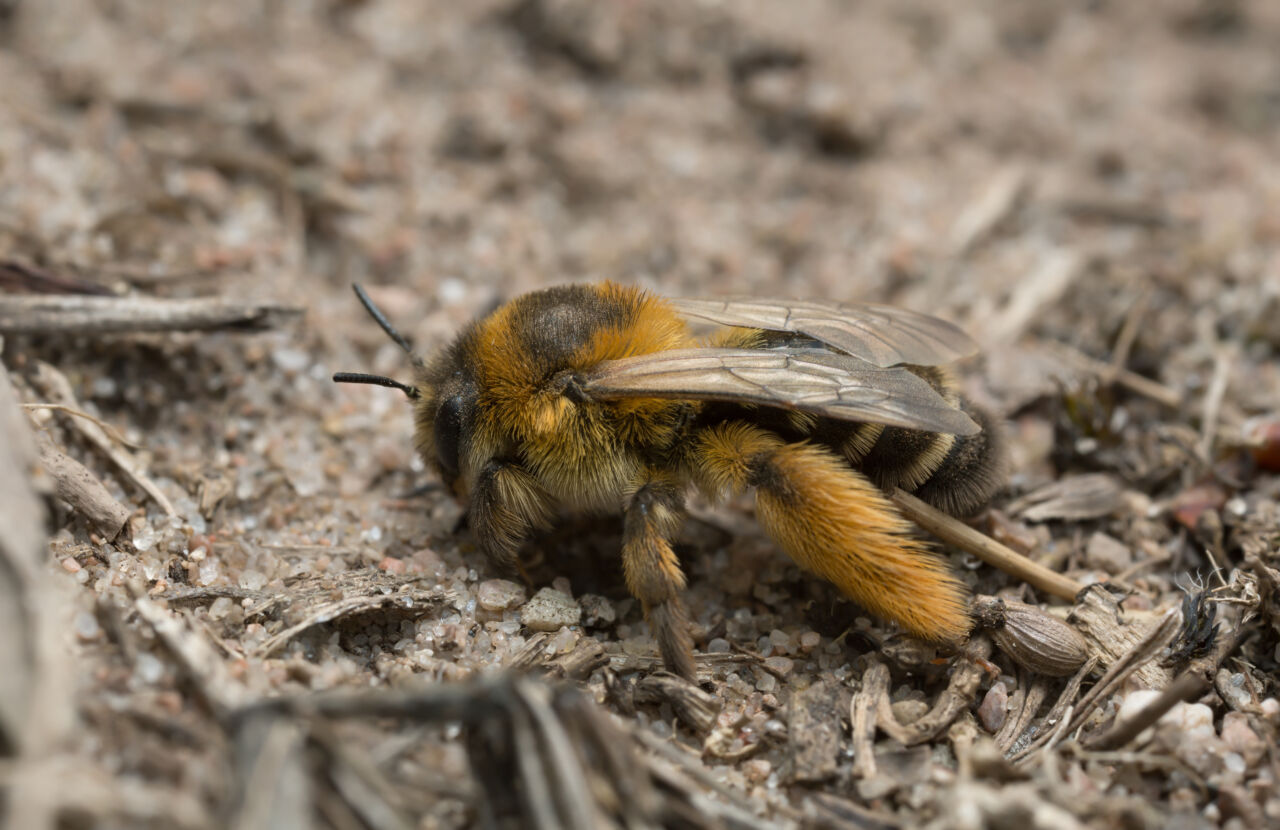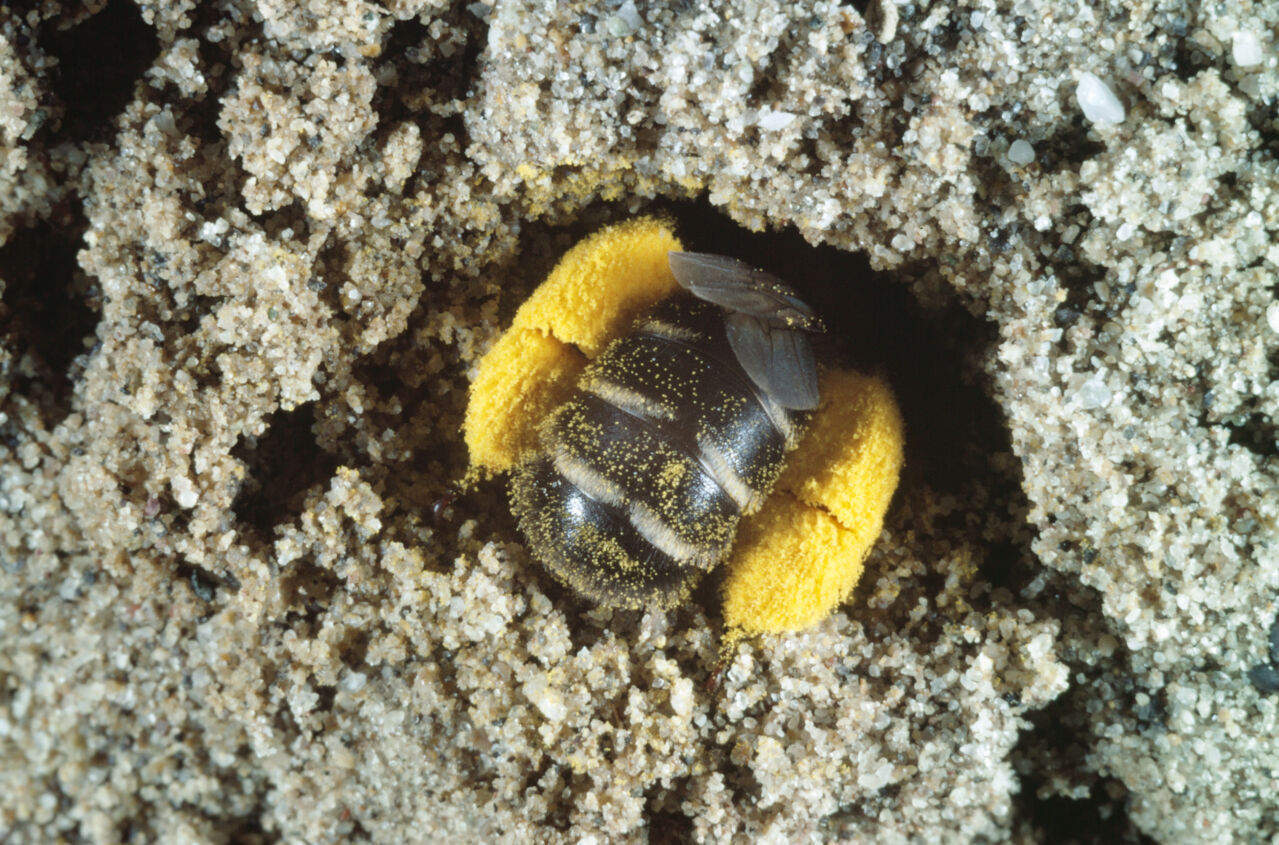Dressed for labor, not for show – The pantaloon bee
With its hairy legs, this solitary bee is a skilled pollen collector and tunnel digger. Although classified as a species of "Least Concern," it is threatened by habitat loss and fragmentation, making conservation efforts crucial to preserve its role in the ecosystem.

The females of the pantaloon or hairy-legged mining bee can be identified by their hairy hind legs that seem to be wearing baggy pants. Image: Adobe Stock
Profile
- Pantaloon bees – also called hairy-legged mining bees – belong to the relatively small family Melittidae.
- They are medium-sized bees that typically measure between 10 and 15 millimeters in length.
- They have a yellowish-brown coloration on the thorax and black and golden-brown bands on the abdomen which are usually highly contrasting.
- Females have very long hairs on their hind legs, giving them the appearance of wearing baggy pants. Moreover, the species name ‘hirtipes’ also means hairy feet.
- They are most commonly found in the warmer parts of Europe, including southern and central Europe, and in the Mediterranean region.
- In Switzerland, they can be found in the lowlands and foothills up to an altitude of 1 500 meters.
- They commonly inhabit open habitats such as meadows, gardens and parks, and are particularly fond of areas with sandy or clay soils. They are well adapted to and have become increasingly common in urban environments, nesting in the soft mortar of old walls and buildings.
Classification
- Kingdom
- Animalia
- Phylum
- Arthropoda
- Class
- Insecta
- Order
- Hymenoptera
- Family
- Melittidae
- Genus
- Dasypoda
- Species
- D. hirtipes
When hairy legs are a plus
The females of this species are characterized by strikingly hairy legs which give the appearance of baggy pants. These hairs, known as scopae or pollen brushes, are used by the female bees to collect pollen from flowers. The long hairs create a large surface area that allows the bee to efficiently gather pollen as it moves from flower to flower.
In addition to collecting pollen, the bees use the long hairs on their hind legs to brush away loose sand as they dig out their burrows with their mandibles. This behavior is particularly important for females, as they are responsible for excavating the nesting tunnel and constructing the brood cells. This adaptation allows the bees to create a nest that is both secure and well-ventilated, promoting the health and survival of their offspring.
To view this content, you must accept marketing and third-party cookies.
Life Cycle
The lifecycle of the pantaloon bee begins in early spring when the females emerge from their nests and begin to forage for pollen and nectar. After mating, the females excavate a nest in the ground, usually in a sandy south-facing bank or slope and close to where they emerged. For the construction of the nest, the pantaloon bees dig their burrows using their mandibles and hind legs. Nests are generally deep and can exceed more than 60 cm. The nests consist of a vertical tunnel that branches into several brood chambers with up to 8 cells. The females lay an egg in each cell. They typically collect pollen from a variety of flowers to provision the nest. The impressive brushes on their hind legs allow the females to carry large quantities of pollen during their foraging trips, which they usually make within a radius of two kilometers around their nest.
Females will use pollen and nectar to create a ‘pollen dough’. A single egg is then laid and the cell sealed. Once the eggs have hatched, the larvae feed on the pollen and develop into adult bees, which emerge from the nest the following spring.
Wide-range pollinator
Dasypoda hirtipes is rather fastidious when it comes to choosing food. This species specializes in the daisy family (Asteraceae), collecting pollen from yellow blooming flowers such as ragwort (Senecio jacobaea) or common fleabane (Pulicaria dysenterica). Known sources of pollen include the popular salad plant chicory (Cichorium intybus), sow thistle (Sonchus spec.) and autumn dandelion (Leontodon autumnalis). Their importance as pollinators has led to increased interest in their conservation, especially in light of the decline of other bee species.

A pantaloon bee entering her nest with her pants full of pollen. Image: Entomologie/Botanik, ETH Zürich, Albert Krebs
Despite their ecological importance, the IUCN Red List classifies Dasypoda hirtipes as a species of "Least Concern." However, this should not be interpreted as an indication that the species is not in need of conservation attention. Pantaloon bees, like many other bee species, are threatened by habitat loss and fragmentation, pesticide use, and climate change. Efforts to promote the conservation of this species, and other wild bees, are important for ensuring the continued provision of pollination services that are essential for the maintenance of many ecosystems and the food production systems on which we rely
Did you know?
The females of the pantaloon bee most often nest in villages which sometimes consist of hundreds or even several thousand nests. In one community in Belgium, for example, the “Tout-lui-Faut” sandpit is home to a colony that included 120 active nests during the summer of 2006.
Save the sand dunes!
Sand dunes are well-drained habitats with relatively low nutrient content that provide ideal conditions for certain plants. Many species, including bees of the Melittidae family although not D. hirtipes, rely on this small number of plants for food and nesting and in return ensure the plants' reproduction. Unfortunately, sand dune habitats are among the most threatened and degraded ecosystems in the world, with many areas being destroyed or modified for human development, agriculture, or other purposes. As a result, many rare and endangered species, including Melittidae bees, are at risk of extinction. Protecting and preserving sand dune habitats is, therefore, essential for the survival of these important species and the ecosystem services they provide, such as pollination.
References
Yang J et al. 2010. Nesting biology of Dasypoda hirtipes (Fabricius) (Hymenoptera: Melittidae). Acta Entomologica Sinica, 53(4): 442-448.
Danforth BN et al. 2019. The solitary bees: biology, evolution, conservation. Princeton University Press.
Packer L. 2023. Bees of the World: A Guide to Every Family (Vol. 5). Princeton University Press.
Fischer LK et al. 2016. Disentangling urban habitat and matrix effects on wild bee species. PeerJ, 4: e2729. https://doi.org/10.7717/peerj.2729
Michez D et al. 2008. Phylogeny and host-plant evolution in Melittidae sl (Hymenoptera: Apoidea). Apidologie, 39(1): 146-162. https://doi.org/10.1051/apido:2007048
Michener CD 2007. The bees of the world , The Johns Hopkins University Press, Baltimore
Amiet F. & Krebs A. 2012. Central European bees - genera, lifestyle, observation, Haupt Verlag, Bern
